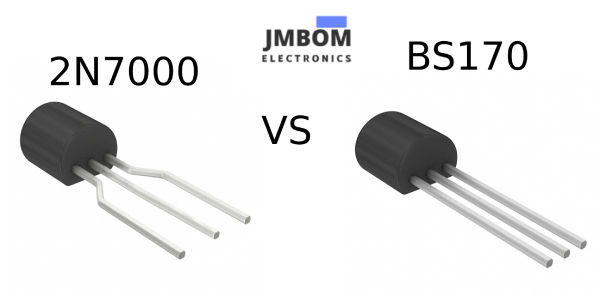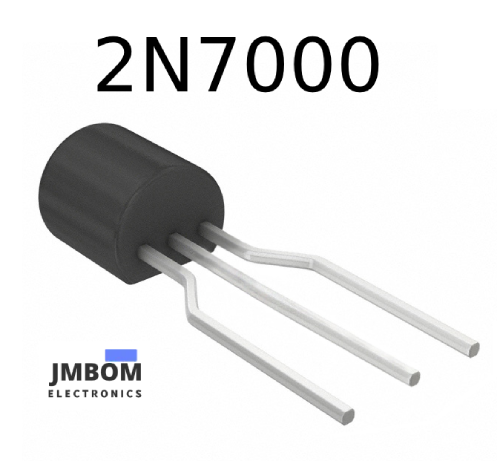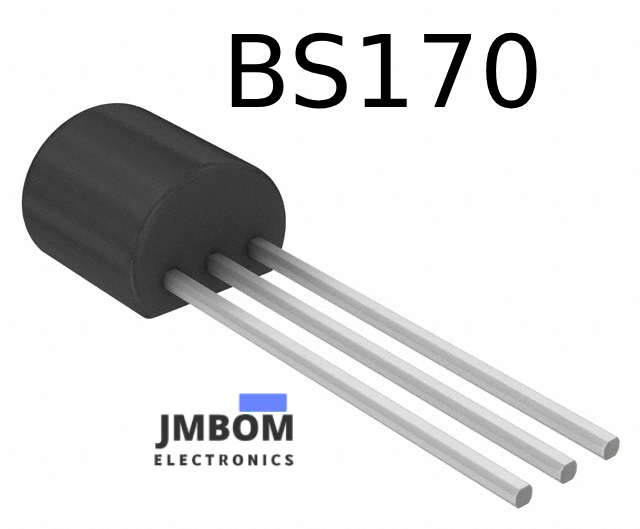

2N7000 vs BS170:N-channel MOSFETs
Catalog
What is a 2N7000?What is BS170?2N7000 vs BS170: SpecificationsApplicationsBS170 vs 2N7000 SpecificationsFinal VerdictFrequently Ask QuestionsThe 2N7000 and BS170 N-channel MOSFETs are widely utilized across numerous electronic applications. Although these two transistors share certain similarities, their distinct specifications render them more appropriate for different types of applications. Gaining a solid understanding of the primary differences between the 2N7000 and BS170 can facilitate the selection of the optimal component for switching, amplification, or signal modulation. A comprehensive comparison of each transistor's electrical characteristics, performance parameters, and practical applications has been carried out to identify which one is best suited for specific requirements in 2024.

2N7000 vs BS170
What is a 2N7000?

2N7000
The 2N7000 is characterized by its low on-resistance and fast switching capabilities. These devices are typically housed in a TO-92 package and operate within a voltage range that enables their use in a wide range of low-to-medium power applications. The 2N7000 delivers reliable performance, simplicity, and robustness in digital circuits, analog switches, and power management functions. Its ability to handle moderate current loads and compatibility with CMOS and TTL logic levels make it a valuable component in the design of efficient and effective electronic circuits.
What is BS170?
The BS170 is frequently employed as a switching and amplification MOSFET in electronic circuits due to its N-channel enhancement mode. Thanks to its low threshold voltage, it can be easily driven by standard logic levels. Like the 2N7000, the BS170 is packaged in a TO-92 package. It is well-known for its efficiency in terms of current and voltage consumption. The BS170 is highly regarded for its ease of integration and reliability, making it a popular choice in both hobbyist projects and professional designs. Its versatile capabilities encompass signal processing, motor control, and power management, rendering it an excellent option for a variety of electronic needs.

BS170
2N7000 vs BS170: Specifications
2N7000
Low On-Resistance
With a gate-source voltage (Vgs) of 10V, the 2N7000 features a minimal on-resistance of just 1.2 ohms. This low resistance ensures efficient current flow and reduces power dissipation, which is vital for applications requiring high efficiency.
Voltage Capacity
The maximum drain-source voltage (Vds) supported by the 2N7000 is 60V. Circuits operating at voltages higher than this can safely use the 2N7000 without concerns of breakdown due to its high voltage tolerance.
Current Capacity
The 2N7000 can support a continuous drain current (Id) of up to 200mA. This makes it well-suited for low to medium power consumption tasks in digital circuits, signal processing, and small motor control applications.
High-Speed Switching
The 2N7000 is ideal for fast signal switching and pulse-width modulation (PWM) applications that demand rapid switching times.
Gate Threshold Voltage
The gate threshold voltage (Vgs(th)) is between 2V and 3V. This allows the 2N7000 to be driven directly by TTL and CMOS logic levels, streamlining circuit design.
Thermal Stability and Dependability
The 2N7000 offers excellent thermal stability and reliability, ensuring consistent performance under varying operating conditions.
BS170
On-Resistance
At a gate-source voltage of 10V, the BS170 typically has an on-resistance of 5 ohms. While this is higher than the 2N7000, it still delivers efficient performance in low to moderate current applications, although the 2N7000 has the edge in efficiency.
Voltage Capacity
The BS170 can also handle a maximum drain-source voltage (Vds) of 60V, making it suitable for circuits that require high voltage tolerance and versatile operation.
Current Capacity
The BS170 can support continuous drain currents (Id) of up to 500mA. With its ability to manage higher currents, it is ideal for applications that require higher load switching, moderate power amplification, and more demanding current handling.
Gate Threshold Voltage
The gate threshold voltage (Vgs(th)) of the BS170 is also in the 2V to 3V range, similar to the 2N7000, making it compatible with standard logic levels and simple to integrate into digital circuits.
High-Speed Switching
The BS170 excels in quick switching applications, making it suitable for use in RF amplifiers, motor drivers, and power converters that require fast response times.
Thermal Efficiency
Despite challenging environmental conditions, the BS170 maintains solid thermal performance.
Applications
BS170 MOSFET
Switching Circuits
The BS170 is widely used in switching circuits for controlling relays, LEDs, and other low-power components. Its ability to manage moderate current and voltage levels ensures reliable performance with minimal power loss when switching devices on and off.
Motor Drivers
The BS170 is frequently used to control small DC motors in motor driver circuits. It can handle continuous currents of up to 500mA, making it perfect for robotics, toys, and small appliances. Its quick switching speed allows for smooth and precise control of motor speed and direction.
Amplification
In low-power amplification applications, such as audio amplifiers and signal processing circuits, the BS170 provides sufficient gain to amplify small signals. Its low gate threshold voltage allows for easy integration into amplification systems.
Power Converters
The BS170 plays a key role in power regulation and efficient switching in DC-DC converters and voltage regulators. Its fast switching capabilities make it ideal for use in portable electronics and power supplies, optimizing size and efficiency.
RF Amplifiers and Oscillators
The BS170 is also used in radio frequency (RF) amplifiers and oscillators, owing to its low capacitance and fast switching speeds. It is ideal for amplifying RF signals and generating stable oscillations in wireless communication devices, transmitters, and receivers.
2N7000
Digital Logic Circuits
The 2N7000 directly interfaces with CMOS and TTL logic levels in digital logic circuits. It is capable of converting logic levels, gating signals, and switching between digital signals. Due to its low gate threshold voltage, it can be easily driven by microcontrollers, FPGAs, and other digital logic devices, making it suitable for a wide range of digital electronics projects.
Analog Switches
When functioning as an analog switch, the 2N7000 can pass analog signals with minimal distortion. For example, it can be used in sample-and-hold circuits for routing audio signals, multiplexing, and sample-and-hold applications. Its low on-resistance makes it ideal for precision analog applications, as it helps maintain signal integrity.
Power Management
The 2N7000 can perform tasks such as load switching, power sequencing, and battery management in power management applications. It is suitable for distributing power up to 60V in low and medium power circuits. The use of the 2N7000 efficiently manages power flow, reduces power consumption, and enhances system performance.
Motor Control
The 2N7000 is commonly used to control small DC motors. It can be utilized in robotics, toys, and small appliances to control motor speed and direction. It is rated for moderate current loads and its fast switching speed allows for smooth and precise motor operation.
Signal Processing
The 2N7000 can be used in signal processing circuits to manage and manipulate electronic signals. It can be employed in switches, amplifiers, and video switches for audio, video, and communication systems. Its low voltage and high speed make it suitable for high-speed operation in modern signal processing applications.
RF Applications
Although not primarily designed for RF applications, the 2N7000's fast switching capabilities make it suitable for low-power RF circuits. It can be used in circuits such as RF switches, oscillators, and amplifiers as a rapid signal processor.
Low-Power Amplification
The 2N7000 is suitable for low-power amplification in applications like audio circuits and signal conditioning. Its low on-resistance makes it appropriate for preamplifiers and other applications requiring small-signal amplification.
BS170 vs 2N7000 Specifications
To choose the right MOSFET for your specific application, it's crucial to understand the detailed specifications of both the BS170 and 2N7000. Below is a comparison of their key specifications.
BS170 Specifications
- Maximum Drain-Source Voltage (Vds): 60V
- Continuous Drain Current (Id): 500mA
- Peak Drain Current (Id): 1.2A
- Gate-Source Voltage (Vgs): ±20V
- Gate Threshold Voltage (Vgs(th)): 2V to 3V
- On-Resistance (Rds(on)): 1.2Ω to 5Ω (typically 5Ω at Vgs = 10V)
- Total Gate Charge (Qg): 8nC
- Input Capacitance (Ciss): 60pF
- Output Capacitance (Coss): 25pF
- Reverse Transfer Capacitance (Crss): 5pF
- Package Type: TO-92
- Power Dissipation (Pd): 830mW
- Operating Temperature Range: -55°C to 150°C
2N7000 Specifications
- Maximum Drain-Source Voltage (Vds): 60V
- Continuous Drain Current (Id): 200mA
- Peak Drain Current (Id): 500mA
- Gate-Source Voltage (Vgs): ±20V
- Gate Threshold Voltage (Vgs(th)): 2V to 3V
- On-Resistance (Rds(on)): 1.2Ω (typically at Vgs = 10V)
- Total Gate Charge (Qg): 2nC to 5nC
- Input Capacitance (Ciss): 20pF to 30pF
- Output Capacitance (Coss): 8pF
- Reverse Transfer Capacitance (Crss): 5pF
- Package Type: TO-92
- Power Dissipation (Pd): 400mW
- Operating Temperature Range: -55°C to 150°C
Final Verdict
The choice between the 2N7000 and BS170 MOSFETs largely depends on the specific application requirements. The BS170, with its continuous drain current of 500mA, is superior in scenarios that demand higher current handling, such as driving motors and amplifying high-power loads. Its robust current handling capability and high power dissipation make it a reliable choice for applications with demanding requirements.
On the other hand, the 2N7000, with its continuous drain current of 200mA, is better suited for low-current applications. This device excels in digital circuits, signal processing, and low-power switching due to its low on-resistance and gate charge. Its compatibility with standard logic levels also simplifies interfacing with microcontrollers and other digital components.
In summary, if your application requires handling a lot of power and higher currents, the BS170 is the preferable choice. Conversely, for applications with low power requirements, high switching speed, and digital interfacing, the 2N7000 is the standout option. It is essential to align the strengths of the MOSFET with your specific circuit requirements before making a selection.
Frequently Ask Questions
How do BS170 and 2N7000 differ?
Both the BS170 and 2N7000 are available in the TO-92 package and have a voltage rating of 60V. However, the 2N7000 can handle a current of 200mA, while the BS170 supports up to 500mA. These differences make the BS170 better suited for applications requiring higher current, whereas the 2N7000 is ideal for moderate current requirements.
What is the BS170?
The BS170 is an N-channel enhancement-mode MOSFET designed using high cell density DMOS technology. This high-density manufacturing process helps reduce on-state resistance while ensuring robust, dependable, and fast switching performance.
What is the 2N7000 used for?
The 2N7000 is an N-channel enhancement-mode MOSFET commonly used in low-power switching circuits.
Is the 2N7000 an NPN or PNP?
The 2N7000 is an N-channel MOSFET.
What is the complementary MOSFET to the 2N7000?
Under certain conditions (12V, 33kHz), the BS250P can be used as the complementary MOSFET for the 2N7000.
Which MOSFET is superior?
Because electrons have higher mobility—about two to three times that of holes—moving holes in a P-channel device is more difficult than moving electrons in an N-channel device. This results in higher on-state resistance in P-channel MOSFETs compared to N-channel MOSFETs.
What is the P-channel counterpart of the 2N7000?
The complementary P-channel MOSFET for the 2N7000 is generally the BS250.
Subscribe to JMBom Electronics !













